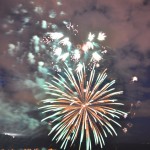With Vancouver’s Celebration of Light fireworks festival just around the corner, I thought I’d give some pointers on how to snap pics of fireworks. And for this, you don’t need a fancy DSLR to take shots – many point-and-shoot cameras can take amazing pictures.

Regardless if you’re using a DSLR or a point-and-shoot, you will need a tripod. Without a tripod, the images will come out blurry and unfocused; the wow factor will turn to woe. You won’t need a professional tripod either – I’ve shot the Celebration of Light using a cheap $10 mini-tripod with my Canon Powershot A640 and got amazing results.
The whole purpose of using the tripod is to eliminate movement. When a camera’s shutter is open, it becomes sensitive to motion. Even gently tapping the shutter release button can affect the picture. A cable release or a remote shutter release prevents unwanted movement. If you don’t have one of these, consider setting the timer to go off after 10 seconds. Using the timer has a downside – you have to wait for the camera to count down, and if the firework detonates before that, you’re out of luck.

Focusing the camera is important. In order for the auto focus to work, light needs to be present for the camera to adjust itself before taking the picture. Manually adjusting the focus enables a clear shot every time. If your lens permits it, rotate the focus ring to the infinity setting. Sometimes, you may be able to get away with auto focus-as I have-but don’t rely on it. Your eye is better than the camera’s.
A low ISO also helps. ISO numbers are the digital equivalent of the film speed and affects how sensitive the camera’s sensor is to light. A lower number reduces noise, or graininess, seen in some pictures. Setting the ISO to 200 or 400 works well for fireworks. Don’t use auto, or anything higher than 800 to minimize noise.
Now, if you have a point-and-shoot, it may have a fireworks mode built in. Refer to your camera’s manual on how to enable this feature – it chooses all the settings so you don’t have to fiddle with them.
For myself, using my Nikon D5000 DSLR, I shoot in Shutter Priority mode with an ISO between 200-400, aperture set at f/11 for about 2 to 2.5 seconds. The best pictures come as the rocket launches upwards – with the shutter open as the explosion unfolds yields an amazing image. You might discover that adjusting these settings could provide some creative results. The Celebration of Light is spread over three different evenings; if the first pictures don’t turn out, go back for more!
I find that I get more of a visual impact if the lens is zoomed all the way out during a show. The explosions can be quite large and will easily overpower a picture if zoomed all the way in. Using the example picture on the top right, try to get part of the beach or a structure into the picture. Doing so reveals the impressive scale of the pyrotechnics.
When photographing fireworks, never use the flash. There is no purpose fighting fire with fire, so leave the flash off. Using the flash results in terrible pictures along with distracting other people watching the display.
Want to see more fabulous fireworks photos? Browse Gallery or any of the articles tagged with “fireworks“.
Did you find a typographical or factual error in this article? Please let us know!